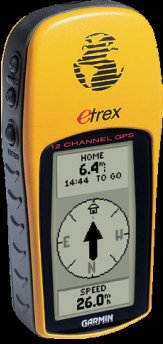|
 Garmin eTrex
Garmin eTrex

I purchased my eTrex in November 2002 in order to work on a software project
involving the GARMIN binary protocol. As such my review of the GPS might be
biased towards the engineering side rather than the more common usability
side. This is not my first GARMIN GPS reciever. My first handheld GPS was a
GPS-12 that was now about approaching four years old, and really needed to
be replaced anyway...
The GPS12 had a failure of the plastic weld joining the two halves of the
unit together about a year ago, and although I have fixed this I am not sure
how good a job I did. Also, the CPU in this unit is a bit slow by modern
standards meaning that it is a bit slow locking on at times. Not a bad unit
by all accounts.
I have also had some Garmin GPS-30 serial eight channel GPS receievrs with
no display. These units really were dogs, but they were cheap by 1997
standards at least. Apart from these units I also have a whole lot of
receievers from about three different manufacturers for embedded
applications
GPS-12 Initial Impressions

When I first saw the unit I was impressed with the small size. The unit is
not much bigger than the internal antenna and the display. The unit takes a
couple of AA batteries and they last a long time. The LCD is quite readable
which is essential for a modern GPS.
Taking the GPS outside to lock for the first time, it asked me some
questions like where it was. Once these were answered the unit very quickly
ontained a solid GPS lock. It was about this time that a couple of things
struck me.
Firstly this unit can get really annoyong... It asks stipid questions like
wanting to know if you are inside if it cant get a GPS lock. This gets
really annoying when you are attempting to do anything inside. The other
problem is the user interface. I REALLY have the keys on this unit. The
GPS-12 was easy to operate. On this unit there are not so many keys and they
are on the side rather than on the front like my older unit.
This may not sound like much of a problem, but I have lost count of the
number of times I have pressed the ESCAPE key rather than the ENTER key. The
user interface really is a pain.
Waypoint Display

The waypoint display screen is not really an improvement on the earlier
models. Thanks to the reduction in the number of buttons, there is no PAN
ability on the map display screen. All you can do is zoom. But you now have
a walking man icon showing where you are on the map. I am sure that this
totally compensates for the loss of the pan feature.
Data Interface

On the back is the new data interface for the eTrex series of GPS receivers.
This plug is more complex than the ones that we have been used to in the
GPS-12. The eTrex plug is flat, and slides on. I am not convinced that it is
an improvement. Like the originals, after market plugs are available from pfranc.com
The interface settings are more limited than the original GPS-12, at least
from my point of view. There is no longer the capability to upload positions
from other equipment in NMEA format. NMEA download is OK, but there is no
upload capability. Reports that I have receieved state that this is because
GARMIN ran out of memory in the device, and that the european version does
have this interface.
The GARMIN binary protocol is included, but has been varied slightly meaning
that there is some software that will not operate with this GPS receiver.
Conclusion

The eTrex basic model from Garmin is a good BASIC model. It does not contain
many of the features found in the more advanced models, but also does not
come with a price tage found on those models.
Our biggest problem with this model was the lack of NMEA UPLOAD capability.
You can buy an eTrex by clicking on the GARMIN graphic at the top of this
page.
____
Welcome to our Techical Site. If you are interested in an overview, then visit our
Marketing Site
Copyright © 1994-2005
Radioactive Networks ,
darryl@radio-active.net.au
This page was last updated 2005-08-31 17:46:40
This page was last compiled 2005-11-15 18:50:45
Question or Comment? Click
here
|

